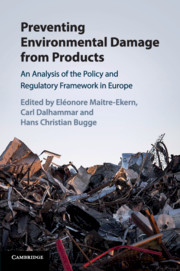 Preventing Environmental Damage from Products
Preventing Environmental Damage from Products Book contents
- Reviews
- Preventing Environmental Damage from Products
- Preventing Environmental Damage from Products
- Copyright page
- Dedication
- Contents
- Figures
- Tables
- Contributors
- Acknowledgements
- Abbreviations
- 1 Developing Legislation to Prevent Environmental Damage from Products
- Part I Structural Issues Associated with Regulating the Life Cycle of Products
- Part II Challenges Related to the Application of European Product Law
- 7 Dieselgate and the Protection of the Environment by Public Authorities
- 8 Energy Efficiency Regulations, Market and Behavioural Failures and Standardization
- 9 Regulating Recyclability under the Ecodesign Directive
- 10 Material Recycling without Hazardous Substances
- 11 Complexities and Conflicts in Controlling Dangerous Chemicals
- 12 Long-Term Market Effects of Green Public Procurement
- Part III Conclusion by the Editors
- Index
11 - Complexities and Conflicts in Controlling Dangerous Chemicals
The Case of Regulating Endocrine Disruptors in EU Law
from Part II - Challenges Related to the Application of European Product Law
Published online by Cambridge University Press: 21 April 2018
- Reviews
- Preventing Environmental Damage from Products
- Preventing Environmental Damage from Products
- Copyright page
- Dedication
- Contents
- Figures
- Tables
- Contributors
- Acknowledgements
- Abbreviations
- 1 Developing Legislation to Prevent Environmental Damage from Products
- Part I Structural Issues Associated with Regulating the Life Cycle of Products
- Part II Challenges Related to the Application of European Product Law
- 7 Dieselgate and the Protection of the Environment by Public Authorities
- 8 Energy Efficiency Regulations, Market and Behavioural Failures and Standardization
- 9 Regulating Recyclability under the Ecodesign Directive
- 10 Material Recycling without Hazardous Substances
- 11 Complexities and Conflicts in Controlling Dangerous Chemicals
- 12 Long-Term Market Effects of Green Public Procurement
- Part III Conclusion by the Editors
- Index
Summary
- Type
- Chapter
- Information
- Preventing Environmental Damage from ProductsAn Analysis of the Policy and Regulatory Framework in Europe, pp. 276 - 302Publisher: Cambridge University PressPrint publication year: 2018


